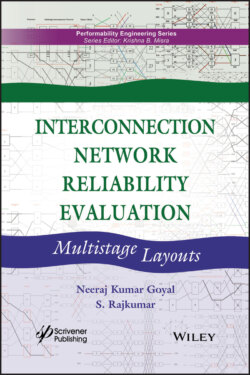Interconnection Network Reliability Evaluation

Реклама. ООО «ЛитРес», ИНН: 7719571260.
Оглавление
Neeraj Kumar Goyal. Interconnection Network Reliability Evaluation
Table of Contents
List of Tables
List of Illustrations
Guide
Pages
Interconnection Network Reliability Evaluation. Multistage Layouts
Series Editor Preface
Preface
1. Introduction. 1.1 Introduction
1.2 Network Reliability Measures
1.3 The Probabilistic Graph Model
1.4 Approaches for Network Reliability Evaluation
1.5 Motivation and Summary
2. Interconnection Networks. 2.1 Interconnection Networks Classification
2.2 Multistage Interconnection Networks (MINs)
2.3 Research Issues in MIN Design
2.4 Some Existing MINs Implementations
2.5 Review of Topological Fault Tolerance
2.5.1 Redundant and Disjoint Paths
2.5.2 Backtracking
2.5.3 Dynamic Rerouting
2.6 MIN Topological Review on Disjoint Paths
2.6.1 Single-Disjoint Path Multistage Interconnection Networks
2.6.2 Two-Disjoint Paths Multistage Interconnection Networks
2.6.3 Three-Disjoint Paths Multistage Interconnection Networks
2.6.4 Four-Disjoint Paths Multistage Interconnection Networks
2.7 Hardware Cost Analysis
2.8 Observations
2.9 Summary
3. MIN Reliability Evaluation Techniques. 3.1 Reliability Performance Criterion
3.1.1 Two Terminal or Terminal Pair Reliability (TPR)
3.1.2 Network or All Terminal Reliability (ATR)
3.1.3 Broadcast Reliability
3.2 Approaches for Reliability Evaluation
3.2.1 Continuous Time Markov Chains (CTMC)
3.2.2 Matrix Enumeration
3.2.3 Conditional Probability (CP) Method
3.2.4 Graph Models
3.2.5 Decomposition Method
3.2.6 Reliability Block Diagram (RBD)
3.2.7 Reliability Bounds
3.2.7.1 Lower Bound Reliability
3.2.7.2 Upper Bound Reliability
3.2.8 Monte Carlo Simulation
3.2.9 Path-Based or Cut-Based Approaches
3.3 Observations
4. Terminal Reliability Analysis of MIN Layouts
4.1 Chaturvedi and Misra Approach
4.1.1 Path Set Enumeration
4.1.2 Reliability Evaluation using MVI Techniques
4.1.3 Reliability Evaluation Techniques Comparison
4.1.3.1 Terminal Reliability of SEN, SEN+ and SEN+2
4.1.3.2 Broadcast Reliability of SEN, SEN +, and SEN+2
4.1.3.3 Comparison
4.2 Reliability Analysis of Multistage Interconnection Networks
4.3 Summary
5. Comprehensive MIN Reliability Paradigms Evaluation. 5.1 Introduction
5.2 Reliability Evaluation Approach
5.2.1 Path Set Enumeration
5.2.1.1 Assumptions
5.2.1.2 Applied Approach
5.2.1.3 Path Tracing Algorithm (PTA)
5.2.1.4 Path Retrieval Algorithm (PRA)
5.3 Reliability Evaluation Using MVI Techniques
5.4 Summary
6. Dynamic Tolerant and Reliable Four Disjoint MIN Layouts
6.1 Topological Design Considerations
6.1.1 Topology
6.1.2 Switch Selection for Proposed 4DMIN
6.2 Proposed 4-Disjoint Multistage Interconnection Network (4DMIN) Layout
6.2.1 Switching Pattern
6.2.2 Redundant and Disjoint Paths
6.2.3 Routing and Dynamic Rerouting
6.2.4 Algorithm: Decision Making by Switches at Each Stage
6.2.5 Case Example
6.2.6 Disjoint and Dynamic Rerouting Approach in 4DMIN
6.2.7 Hardware Cost Analysis
6.3 Reliability Analysis and Comparison of MINs
6.4 Reliable Interconnection Network (RIN) Layout
6.4.1 Topology Design
6.4.2 Switching Pattern
6.4.3 Routing and Dynamic Rerouting
6.5 Reliability Analysis and Comparison of MINs
6.6 Summary
References
Index
Also of Interest
WILEY END USER LICENSE AGREEMENT
Отрывок из книги
Scrivener Publishing 100 Cummings Center, Suite 541 JBeverly, MA 01915-6106
.....
Communication networks are generally modeled using network graph [3]. The network graph G (V,E) consists of a set V of n number of nodes (or vertices) and a set E of l number of edges (or links). For reliability evaluation, probabilistic graph is used which takes these sets V and E of nodes and links as random variables. In probabilistic graph of communication networks, nodes represent the computers/ switches/transceivers/routers and edges represent various types of communication links connecting these nodes. For reliability analysis, graphical models of networks are considered to be simple, efficient and effective.
Probabilistic graph models are developed and presented in this book. Depending on the state (working or failed) of nodes (or vertices) and/or links (or edges), the network can be considered either working or failed. A general assumption of statistical independence among nodes and links failures is followed throughout. It implies that the probability of a link or node being operational is not dependent of the states of the other links or nodes in the network. The inherent assumption here is that the link failures are caused by random events which affect all network components individually.
.....